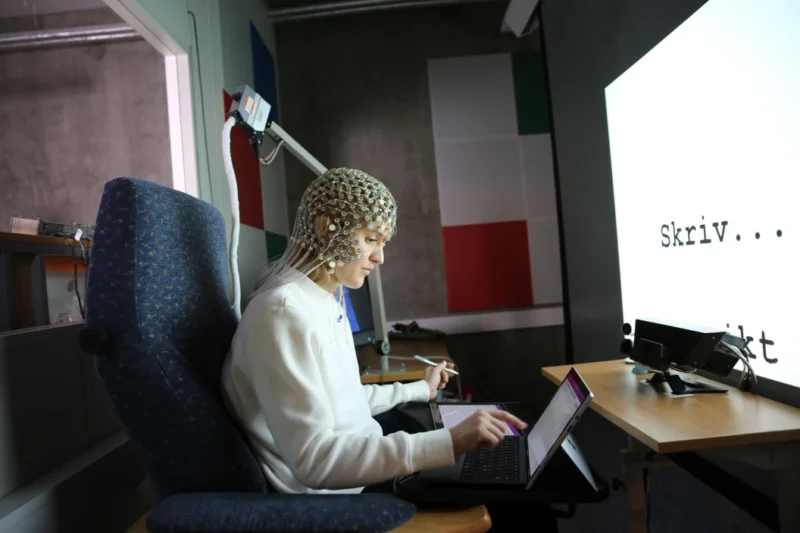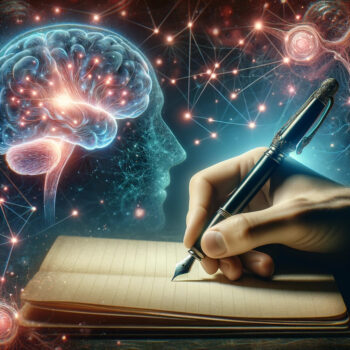By Lily Anderson
Staff Writer for Wake Up World
In an era dominated by digital interfaces, the timeless art of handwriting seems to be fading away, replaced by the brisk click-clack of keyboards. However, a groundbreaking study has delved deep into the neural landscapes of the brain, revealing intriguing insights into the dynamics of hand- versus typewriting. The findings illuminate a fascinating link between handwriting and enhanced brain connectivity, suggesting that the traditional act of penning letters by hand may hold profound implications for learning and memory retention.
[pro_ad_display_adzone id=”110028″]
Unraveling the Brain’s Response to Hand- and Typewriting
In a world where screens reign supreme and keyboards commandeer our daily interactions, the act of writing by hand is increasingly becoming a relic of the past, particularly in educational settings. While typing offers speed and efficiency, the merits of handwriting extend far beyond mere penmanship. Recent research conducted by Prof. Audrey van der Meer and her team at the Norwegian University of Science and Technology sought to unravel the intricate neural mechanisms underlying handwriting and typewriting.
“We show that when writing by hand, brain connectivity patterns are far more elaborate than when typewriting on a keyboard,” Prof. van der Meer explains, shedding light on the profound implications of manual writing processes. Published in Frontiers in Psychology, the study unveils a compelling correlation between the complexity of brain connectivity and the mode of writing employed.
The Pen: A Potent Tool for Cognitive Enhancement
The study, encompassing 36 university students, meticulously examined the neural responses elicited during hand- and typewriting tasks. Participants, tasked with writing or typing words displayed on a screen, underwent EEG recordings to capture brain activity patterns. The results were unequivocal: connectivity between distinct brain regions surged during handwriting sessions, a phenomenon notably absent during typewriting endeavors.
“Our findings suggest that visual and movement information obtained through precisely controlled hand movements when using a pen contribute extensively to the brain’s connectivity patterns that promote learning,” Prof. van der Meer elucidates, emphasizing the pivotal role of manual dexterity in cognitive augmentation.
Movement Matters: The Neurological Significance of Handwriting
Despite the digital veneer of digital pens utilized in the study, the implications extend far beyond touchscreen interfaces. Prof. van der Meer underscores that the act of forming letters with deliberate precision fuels robust brain connectivity, irrespective of the writing medium. Whether etched on paper or traced on a tablet, the sensory engagement inherent in handwriting fosters cognitive enrichment.
Conversely, the monotony of keystrokes pales in comparison, failing to evoke the intricate neural symphony elicited by manual writing. “This also explains why children who have learned to write and read on a tablet can have difficulty differentiating between letters that are mirror images of each other,” Prof. van der Meer observes, underscoring the tactile dimension crucial for letter recognition and spatial awareness.

One of the trial participants – credit, Norwegian University of Science and Technology – via SWNS
Striking a Balance: Navigating the Digital Landscape
In light of these revelations, educators are urged to reconsider the pedagogical paradigms dictating classroom practices. While technological advancements offer unparalleled convenience, the intrinsic value of handwriting should not be overlooked. Guidelines advocating for the integration of handwriting instruction are heralded as a step towards cognitive enrichment, fostering a harmonious blend of tradition and innovation.
“Students learn more and remember better when taking handwritten lecture notes,” Prof. van der Meer notes, underscoring the enduring efficacy of pen and paper. Nevertheless, she emphasizes the importance of embracing technological progress, acknowledging the nuanced interplay between writing modalities and learning contexts.
As we navigate the ever-evolving landscape of education, the humble pen emerges as a potent catalyst for cognitive flourishing. In a world enamored with digital allure, the enduring allure of handwriting persists as a testament to the timeless artistry of human expression.
Practical Tips for Starting a Handwriting Journal
Incorporating the therapeutic practice of journaling into your routine can be a transformative journey, fostering introspection, creativity, and mindfulness. Here are practical steps to embark on your handwriting journaling adventure:
1. Choose Your Tools Wisely
Select a journal that resonates with you aesthetically and tactilely. Whether it’s a sleek leather-bound notebook or a whimsically patterned journal, opt for a format that inspires your creativity and invites exploration.
2. Set the Scene
Designate a serene space conducive to introspection and reflection. Whether it’s a cozy nook bathed in natural light or a tranquil corner of your favorite cafe, cultivate an environment free from distractions where your thoughts can flow freely.
3. Embrace Imperfection
Release the burden of perfection and embrace the organic ebb and flow of your thoughts. Allow your handwriting to meander across the pages, unfettered by the constraints of uniformity. Remember, the beauty lies in the authenticity of your expression.
[pro_ad_display_adzone id=”110030″]
4. Start Small
Initiate your journaling journey with bite-sized entries, gradually expanding as your comfort and confidence grow. Begin with brief reflections on your day, jotting down snippets of gratitude, observations, or aspirations.
5. Experiment with Prompts
Stimulate your creativity with thought-provoking prompts tailored to your interests and aspirations. Explore themes of self-discovery, gratitude, and personal growth, allowing your journal to serve as a sanctuary for exploration and introspection.
6. Cultivate Consistency
Establish a regular journaling practice, weaving it seamlessly into the fabric of your daily routine. Whether it’s a morning ritual to set intentions for the day ahead or an evening reflection to unwind and decompress, prioritize consistency as you nurture your writing practice.
7. Reflect and Refine
Periodically revisit your entries, tracing the contours of your evolving thoughts and emotions. Celebrate moments of insight and growth, while embracing the inherent impermanence of your reflections. Use your journal as a compass, guiding you on your journey of self-discovery and personal transformation.
By infusing your journaling practice with intention and authenticity, you embark on a voyage of self-discovery and self-expression. Let your handwriting serve as a conduit for your innermost thoughts and aspirations, illuminating the path towards profound insight and personal fulfillment.
Reference:
About the author:
Lily Anderson is a passionate wordsmith and dedicated explorer of cutting-edge scientific inquiries. Fuelled by a thirst for knowledge, she skilfully transforms intricate ideas into relatable tales, inviting readers to embark on a captivating expedition of revelation. Lily’s efforts play a crucial role in bridging the gap between experts and the wider public, evoking a sense of awe and encouraging insightful discussions about groundbreaking scientific advancements.
[pro_ad_display_adzone id=”110027″]







